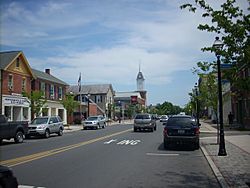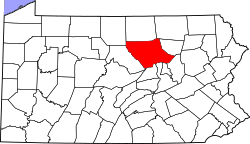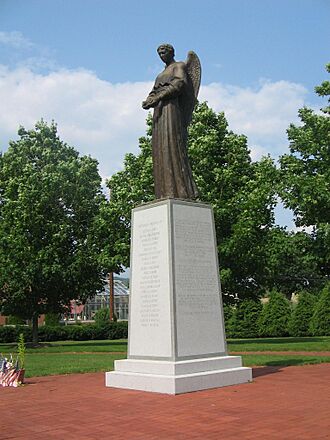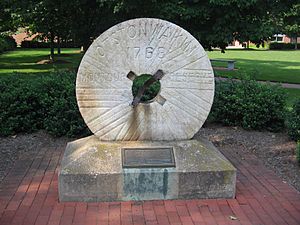Montoursville, Pennsylvania facts for kids
Quick facts for kids
Montoursville, Pennsylvania
|
|
|---|---|
|
Borough
|
|

Broad Street in Montoursville
|
|

Location of Montoursville in Lycoming County, Pennsylvania
|
|

Location of Lycoming County within Pennsylvania
|
|
| Country | United States |
| State | Pennsylvania |
| County | Lycoming |
| Settled | 1820 |
| Incorporated (borough) | 1850 |
| Area | |
| • Total | 4.18 sq mi (10.83 km2) |
| • Land | 3.63 sq mi (9.41 km2) |
| • Water | 0.55 sq mi (1.42 km2) 3.12%% |
| Elevation
(center of borough)
|
540 ft (160 m) |
| Highest elevation
(northeast boundary of borough)
|
660 ft (200 m) |
| Lowest elevation
(West Branch Susquehanna River)
|
496 ft (151 m) |
| Population
(2020)
|
|
| • Total | 4,750 |
| • Density | 1,307.46/sq mi (504.82/km2) |
| Time zone | UTC−5 (Eastern Time Zone (North America)) |
| • Summer (DST) | UTC−4 (EDT) |
| ZIP Code |
17754
|
| Area code(s) | 570 |
| FIPS code | 42-50720 |
| GNIS feature ID | 1213650 |
Montoursville is a small town, called a borough, in Lycoming County, Pennsylvania. In 2020, about 4,745 people lived there. It is part of the larger Williamsport, Pennsylvania area. The Williamsport Regional Airport is also located in Montoursville.
This borough is on the east side of Loyalsock Creek. It is near where an old Native American village called Otstonwakin used to be. Montoursville gets its name from Andrew Montour. He was a French and Native American person. His mother, Madame Montour, was a famous interpreter and negotiator. She worked with the British government in New York and Pennsylvania in the early 1700s. Her son, Andrew, also became an important interpreter and negotiator. He helped during the French and Indian War.
Contents
History of Montoursville
Early Native American Village
Otstonwakin was a Native American village. It was located where Loyalsock Creek meets the West Branch Susquehanna River. A path called the Great Shamokin Path ran along the river's west bank. Archeologists have found that most of the village was on this side.
In the 1730s and 1740s, this village became a key stop for Moravian missionaries. These missionaries shared their beliefs in the Pennsylvania frontier. For example, Count Zinzendorf, a missionary, visited Otstonwakin in 1742. He was guided by Conrad Weiser and had permission from the Oneida chief Shikellamy.
Madame Montour: An Influential Interpreter
Madame Montour was likely of Algonkin-French background. She was born in Quebec. One story says she was captured by the Iroquois and adopted into an Iroquois family. She spoke French, English, and several Native American languages. This made her very important in New York. She even worked as a personal interpreter for Governor Robert Hunter.
She and her Oneida husband, Carondawana, moved to Pennsylvania by 1727. He was a war chief. Carondawana was killed in 1729 during a raid. Madame Montour remained influential. She was a friend to the British and represented local Native American groups. She welcomed the white settlers who started moving into the West Branch Susquehanna River Valley. She had a lot of influence with the different tribes in the area. These tribes were feeling pressure from the growing colonies.
Madame Montour had many connections with Native American groups. The British government sometimes paid her slowly for her services. She had to wait a year for payment at one point.
Madame Montour is thought to have had three children. Her son, Louis (also called Lewis), was an interpreter during the French and Indian War. He was killed during this time. Her daughter, Margaret, later known as "French Margaret," became a leader. She led "French Margaret's Town" near the mouth of Lycoming Creek. This was a few miles up the river from Montoursville.
Andrew Montour: Following in His Mother's Footsteps
Her other son, Andrew Montour, took over leadership of Otstonwakin in the 1740s. He was good with languages, just like his mother. He spoke French, English, Lenape, Shawnee, and Iroquoian languages. He was comfortable with both Native Americans and Europeans. He earned a good living by interpreting for tribes and settlers. In 1742, when Count Zinzendorf met Andrew, he said Andrew looked "decidedly European."
Andrew Montour also worked as an interpreter with Conrad Weiser and Chief Shikellamy. The Province of Pennsylvania gave him about 880 acres (3.6 km²) of land in the Montoursville area. Later, he became a captain in George Washington's Army. This was at Fort Necessity during the French and Indian War. Andrew Montour eventually left Montoursville. He moved to Juniata County with his mother. They later settled on Mountour's Island near Pittsburgh. His mother died there in 1753.
Settlement by European Americans
Permanent European-American settlement in this area began after the American Revolutionary War. John Burrows is known as the founder of Montoursville. He sold land to other settlers and became a wealthy and powerful person. He was born in Rahway, New Jersey. When he was young, Burrows delivered mail on horseback. He rode between New York and Philadelphia. He also worked as a courier for General George Washington during the American Revolution.
After the war, Burrows moved to Muncy, Pennsylvania. He worked in the distilling business for several years. He saved money to invest in land near Loyalsock Creek. This land became Montoursville. He bought about 570 acres (2.3 km²) in 1812. Burrows divided his land into lots in 1820. He sold them for $50.00 each. In Lycoming County government, Burrows was a justice of the peace. He was elected county commissioner in 1802. In 1808, he was elected to the Pennsylvania State Senate.
The first people to buy lots in Montoursville settled based on their backgrounds. Germans settled in the eastern part, in a neighborhood called Coffeetown. The English settled in a western neighborhood called Teatown. Besides selling land, Burrows had a very successful farm. He sent his farm products by raft down the Susquehanna River to Baltimore. There, he made a good profit. Burrows also built the town's first gristmill. He continued to sell lots until he died in 1837.
His son, Nathaniel Burrows, was also a businessman. He opened the first general store in town. He got the job to build the West Branch Canal in this part of Lycoming County. Nathaniel Burrows made sure the canal was built closer to the town and his businesses. Montoursville officially became a borough on February 19, 1850.
John Else came to the Montoursville area as a child in 1807. His family farmed along Mill Creek. As a young man, John Else helped build the first permanent bridge over Loyalsock Creek in 1815. He made many improvements in the community. Else built many buildings in Montoursville. He worked with his father on the first permanent house.
Indian Park: A Place for Fun
Indian Park is on the northwest side of Montoursville. Interstate 180 and U.S. Route 220 run next to it. Today, this large park has miles of trails for hiking and biking. It also has softball fields, picnic areas, pavilions, and fishing ponds.
Indian Park was once an amusement park in the late 1800s. It was a trolley park, meaning people could get there by public transportation. Visitors from Williamsport would ride the trolley to Indian Park. They would spend a day having fun along Loyalsock Creek. The park had one of the largest roller coasters on the East Coast. It also had over 20 acres (81,000 m²) of ponds, a theater, and a merry-go-round. The amusement park closed in 1924. This was partly because of the cost to fix things after yearly floods on Loyalsock Creek. Also, more people started using cars to travel to other places for fun.
TWA Flight 800 Tragedy

Montoursville was deeply affected by the explosion of TWA Flight 800. This happened on July 17, 1996, near East Moriches, New York. Out of 230 passengers, 21 were from the Montoursville area. Sixteen of them were Montoursville High School students. They were going on a school trip to France as part of a student exchange program. They were with five adult chaperones.
People from all over the world sent their sympathy to Montoursville. This included messages from Japan, Australia, and Belgium. Governor Tom Ridge and his wife attended a special gathering at the school. A memorial service was also held. New York City mayor Rudy Giuliani and Pennsylvania senator Rick Santorum attended it. President Bill Clinton, the U.S. softball team at the Atlanta Olympics, and the French ambassador to the United States also sent their condolences.
A memorial was built at Montoursville High School. It has a statue of an angel made by James Barnhill. The base of the statue has the names of the 21 local victims. It also tells a short story of what happened. The memorial stands in a circle of 21 trees, one for each person lost. The angel was chosen because people thought a cloud seen above the high school on July 21, 1996, looked like an angel. It had 21 small clouds at its feet. Randolph Hudson designed the memorial, and Beth Hershberger designed the landscaping.
The five adult chaperones were:
- Debbie Dickey, a French teacher at Montoursville Area High School
- Doug Dickey, her husband
- Carol Fry, a former school board member
- Judith Rupert, a high school secretary
- Eleanor Wolfson, mother of student Wendy Wolfson
The 16 students were:
- Jessica Aikey
- Daniel Baszczewski
- Michelle Bohlin
- Jordan Bower
- Monica Cox
- Claire Gallagher
- Julia Grimm
- Rance Hettler
- Amanda Karschner
- Jody Loudenslager
- Cheryl Nibert
- Kimberly Rogers
- Larissa Uzupis
- Jacqueline Watson
- Monica Weaver
- Wendy Wolfson
Geography of Montoursville
Montoursville is bordered by the West Branch Susquehanna River and Armstrong Township to the south. Loyalsock Creek forms the northern and western border with Loyalsock Township. Fairfield Township is to the north and east. Montoursville is about 130 miles (209 km) northwest of Philadelphia. It is about 165 miles (266 km) east-northeast of Pittsburgh.
Montoursville is located at coordinates 41°15′10″N 76°54′56″W. The U.S. Census Bureau says the borough covers about 4.2 square miles (10.8 km²). Most of this, 4.0 square miles (10.5 km²), is land. About 0.1 square mile (0.3 km²), or 3.12%, is water.
Population and People
| Historical population | |||
|---|---|---|---|
| Census | Pop. | %± | |
| 1850 | 228 | — | |
| 1860 | 369 | 61.8% | |
| 1870 | 1,048 | 184.0% | |
| 1880 | 1,193 | 13.8% | |
| 1890 | 1,278 | 7.1% | |
| 1900 | 1,665 | 30.3% | |
| 1910 | 1,904 | 14.4% | |
| 1920 | 1,949 | 2.4% | |
| 1930 | 2,710 | 39.0% | |
| 1940 | 3,019 | 11.4% | |
| 1950 | 3,293 | 9.1% | |
| 1960 | 5,211 | 58.2% | |
| 1970 | 5,985 | 14.9% | |
| 1980 | 5,403 | −9.7% | |
| 1990 | 4,983 | −7.8% | |
| 2000 | 4,777 | −4.1% | |
| 2010 | 4,615 | −3.4% | |
| 2020 | 4,745 | 2.8% | |
| 2021 (est.) | 4,715 | 2.2% | |
| Sources: | |||
In 2000, there were 4,777 people living in Montoursville. There were 2,067 households and 1,393 families. The population density was about 1,181 people per square mile (456 per km²). Most residents, about 99%, were White.
About 28% of households had children under 18. About 53.6% were married couples. The average household had 2.31 people. The average family had 2.84 people.
The population was spread out by age:
- 23.4% were under 18
- 5.2% were 18 to 24
- 26.1% were 25 to 44
- 22.6% were 45 to 64
- 22.7% were 65 or older
The average age was 42 years. For every 100 females, there were about 90.5 males.
The median income for a household was $37,484. For a family, it was $44,583. About 4.2% of the population lived below the poverty line. This included 2.4% of those under 18.
Education in Montoursville
The Montoursville Area School District includes several schools:
- Loyalsock Valley Elementary School
- Lyter Elementary School
- C.E. McCall Middle School
- Montoursville Area High School
Notable People from Montoursville
Many interesting people have come from Montoursville:
- Blaise Alexander, a NASCAR race car driver
- Dick Barrett "Kewpie", a baseball player
- Garth Everett, a Pennsylvania state lawmaker
- John Gosse Freeze, a lawyer and writer from the 1800s
- Johnny Jolin, a Country music artist
- Adam Makos, an author
- Kelly Mazzante, a WNBA basketball player
- Mike Mussina, a baseball pitcher for the Baltimore Orioles and New York Yankees
- Tom O'Malley, a baseball player
- Aaron Ryder, a film producer
- Eugene Yaw, a Pennsylvania State Senator
See also
 In Spanish: Montoursville para niños
In Spanish: Montoursville para niños


